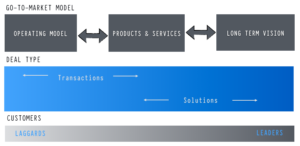
by scott.gillum | Jun 18, 2018 | 2018, Opinion
The experience of selling our house has been a good reminder of the importance of goodwill in the negotiating process.
We were fortunate to get a couple of offers on our home. Hearing feedback from our neighbors and realtors, we learned that one couple with young children really loved our home, especially the trampoline in the backyard!
As we responded to the offers we made it clear to the realtor of a family with the young children that we really wanted them to have the house. Our children, now in college, were a similar age when we first bought the house. The neighborhood was a great place to raise kids and we thought it would be nice to “complete the circle.”
And that’s when the trouble started. Our counteroffer made it clear that we were negotiating in good faith trying to meet the couple in the “middle.” Except they didn’t. They stood their ground forgoing the traditional comprise an approach to pursuing a “we win, you lose” stance. As an emotionally charged seller, I can confirm that this tactic did not go over well.
The disconnect was that we were selling a home full of memories which we wanted to pass along to another young family. As the buyers, they were just making a purchase decision at the best price as possible. It was a transaction for them. And with that, they took out all of the goodwill.
For example, the family was moving to the area from out of town. We’ve lived in the area for thirty years, 14 years in our current location. There are things that would have been helpful to know about our home, our neighborhood and our community. Our children attended the school their children will mostly attend. Played on the soccer fields, and in the school gyms where their kids will play. Insights from a resident on teachers, coaches, neighbors are usually helpful to someone new to an area.
Because they changed the rules of the game none of that conveyed. The relationship had been killed. Think about that when you’re negotiating a business deal. Deals are made between humans so emotions are involved. In the end, you may get your price but at what cost? What goodwill may have been lost? What could the seller tell you that could help with implementation, use of the product/service, etc.
The secret to a good deal is that both parties feel like they gave up something but that they also got something in return. You may feel good about the short-term gain — but by making the other party the “loser” it might cost you in long run.
by scott.gillum | Oct 31, 2017 | 2017, Marketing
 We’ve tried surveys, but they say one thing and then do another. One on one sessions, yep, tried those as well. How do we really know what our clients want? Over the last few months, I’ve had the opportunity to speak with close to fifty marketers, friends, clients and former colleagues. I didn’t have an agenda or a pitch, just a conversation about their career path and how they decided on their professions.
We’ve tried surveys, but they say one thing and then do another. One on one sessions, yep, tried those as well. How do we really know what our clients want? Over the last few months, I’ve had the opportunity to speak with close to fifty marketers, friends, clients and former colleagues. I didn’t have an agenda or a pitch, just a conversation about their career path and how they decided on their professions.
The conversation eventually made its way into a discussion of relationships they had with various consultants, advisors, and agencies. Just for kicks, I built a word cloud from my notes and saw five themes emerged around what they wanted from a vendor — I call it the five “S’s”.
- Smarts – this was a common theme — “I don’t want to have to explain my business to the vendors that I work with. They need to do their homework.” Almost every conversation had an element of the client wanting vendors to be up to speed when the engagement started. Time is money and clients don’t have the time (especially on their dime) to get you up to speed. And, for big consulting firms and agencies, don’t get comfortable with thinking you have a lock on all the brightest folks. They use plenty of very smart individual contractors. Many of them, just came from your world.
- Skills – similar to the above comment, clients want to work with agencies and consultants that have the skill sets that they can’t find, hire or retain. This was especially important when it came to digital talent. They have made investments in MarTech but are having a hard time finding the talent to optimize, or even operate, the technology…and it is becoming more difficult.
- Speed – “I need the vendors I hire to operate at the speed of my business,” said the CMO of a Fortune 50 hi-tech firm and others echoed her comment. There were also comments related to responsiveness. If you’re standard policy is to respond to a clients’ email within 48 hours, you’re about 40 hours off on their expectations. Being more responsive can buy you time on deliverables. Clients want to know, or at least feel, like you’re making progress on their effort. Gaps in communication create the risk of your client feeling like they are not getting the attention they deserve or pay for…and they know when you’re stretched too thin.
- Simple – combine Smarts with Speed and you get Simple or at least that is what the client would love. They want to be able to understand your recommendations so they know exactly what decisions, or action, to immediately execute. Consultants — they are tired of the upsell, where one problem suddenly surfaces another problem, especially when they haven’t received the output of the first project. Agencies — the more complexity you add to a campaign the longer clients believe it will take to execute. Smart, valued vendors take complex problems and make them simple to understand and resolve. They know they have other issues they just need to address the problem in front of them.
- Spirit – this one surprised me and took some time to understand. The core of this theme was rooted in marketers stating that they wanted to work with vendors who were “enthusiastic” about their business, or “passionate” about their own jobs/role. They want a partner who brings some fun and/or passion that may be lacking in their organization. If you are pitching an idea an important part of the “sell” job is how you deliver it. If you’re not excited about it, they won’t be either. The last thing you want is a client who doesn’t want to talk to you because they know it won’t be enjoyable…they have plenty of those meetings internally. Be their break in the day, the good news, the breath of fresh air they so desperately need…especially at the end of the day or week.
Surprisingly, I didn’t hear cheaper. Don’t misunderstand, they want value and recognize that to get it they have to make the investment. Now that you know what they really want that shouldn’t be a problem to deliver, be the bright spot in their day.
by scott.gillum | Nov 21, 2016 | 2016, Sales
Last week Tibor Shanto from Renbor Sales Solutions mentioned in his post that I questioned the value of the sales organization. Given the information shared with us at the CEB Sales and Marketing Roundtable meeting we attended, the question was relevant. He goes on to state that what I was really asking is why are so many sales reps struggling and what could marketing do to help them succeed. If the sales organization struggles, most likely marketers will struggle, and they may be the ones who will get the blame.
The more I thought about it the more convinced I became that the issue goes beyond sales and marketing, and their ability to correct it. I don’t think marketing can fix what ails sales, and vise versa. To illustrate the issue, I have created a framework that oversimplifies an organization go-to-market model. The core of the GTM model is the operating model, the product and services group and the organizations long-term vision.

Each part of the model plays an important role in determining the success of an organization. Additional detail on each group is contained below.
- Operational Model – the core of the business, how it delivers value to customers. It is also focused on driving efficiency and effectiveness in the delivery model.
- Product/Services – the physical manifestation of the value.
- Vision – how the company articulates their view of the world, now and in the future based on consumer/customer, competitor and market trends and needs.
Marketing develops and articulates the organization’s vision. It should be forward looking (at least three years), and challenge the product organization to “catch up.” It should enable the sales force to sell new solutions, enter new markets and differentiate the organization against competitors.
The product group builds, tests and perfects products, services and solutions that meet the needs of buyers today, and in the future. It should be able to define the market opportunity and the best route to capture it.
The “operating model” should be constantly evaluating those products and services most strategic to the organization (revenue, profit, etc.) and how to scale them. In some of the best organizations I’ve seen, this group enable the “visionary” solution sales reps to sell whatever they want early in a “wave,” as it works to pair down offerings to the few that are the most desired (market demand and/or profitability) As a result, choice, selection and pricing are simplified which helps them scale and enables the sales force to sell efficiently.
Aligning The Sales Organization
Solution Sales team – the solution selling team should be aligned to the front end of the go-to-market model. They have the capability, experience and navigation skills to configure and sell the vision and complex solution, both to internal and external audiences.
Product Specialist and Account Management teams – AM’s or PS’s are aligned to existing accounts and/or products and may be aligned by industry or type of solution. Their goal is to keep and expand the account. Reps that excel in this role are adept at understanding how to navigate the internal workings of the client — how to work the procurement process, position their products/organization against competitors, gain access to new buyers/opportunities, and how to anticipate future needs.
Telesales and Online Portals – the back end of the go-to-market framework where the “operating model” has shifted low margin “simple” products, to align with knowledgeable buyers. Allowing them to make a purchase transaction at the lowest cost and in the most convenient way possible. Sales reps may also dealing with “laggard” first time buyers who come late to a product or solution and have simple requirements.
Marketing’s role across this continuum varies. For the solution sellers, content marketing is critical and as Tibor states “insights built around business objectives.” Marketing has to help the sales organization articulate the organization’s vision (“air cover”) and the value of the product to the buyer, professionally and personally.
So what’s different about the sales model I laid out? Nothing. Does sales need a new model? Maybe, maybe not, but what it needs right now is the organizations commitment to executing the model that I just described. It isn’t throwing more resources and technology at sales, as the CEB research points out. Almost all (98%) of the sales leaders surveyed by CEB had added resources for sales support over the last four years, yet 76% of sales reps said that they have experienced an increase in the complexity of the support they are receiving.
Organizations have to commit to being good at all parts of the go-to-market model. Many of the organizations shortcomings and/or dysfunctional behavior become sales inhibitors. For example, organizations that are operationally efficient often lack the ability to articulate a long-term vision. On the other end, companies that have their heads in the future often miss simple things like scaling down the number of products sold, or simplifying financing terms or compensation plans.
What I took away from the meeting is, in today’s complex business environment, those organization that can simplify buying will win. The problem is that it’s easier to add and feel like you’re making a difference than it is to subtract or reduce and know that you making progress. It’s time to stop feeling like you’re making a difference and start putting a shoulder to making it happen.
by scott.gillum | Feb 28, 2016 | 2016, Marketing
 Having a hard time convincing “the powers that be” to invest in the brand? Ever wonder why it’s so hard, why all they want from marketing is leads? Let me explain.
Having a hard time convincing “the powers that be” to invest in the brand? Ever wonder why it’s so hard, why all they want from marketing is leads? Let me explain.
In organically grown companies, an organization develops a product or service and goes to market through a sale channel, either owned or via a partner. At this point, the organization is focused on acquiring customers and generating revenue. With low market awareness the organization typically has more sales capacity than demand for its products or services.
If marketing exists, it’s in its infancy, and plays a tactical role developing sales material, supporting business development activities, and it may have a small social media presence.
To fuel the company’s growth, the management team begins to realize in order to make sales and revenue objectives it has to be able to create demand beyond what the sales channels can generate on its own. As a result, marketing expands beyond its most basic sales enablement role into being responsible for generating leads.
When growth slows and/or begins to plateau, the executive management team will (or should) begin to explore the value of “strategic” marketing. Unfortunately, these strategic marketing activities and investments aimed at broadening awareness of the brand are often misunderstood and/or dismissed all together. Here’s why they shouldn’t be, and why they are critical to unlocking a company’s next phase of growth.
Why it’s so hard getting to “Yes”
The challenge in convincing the organization that marketing can be a strategic growth level is one of perception. Because marketing evolves “bottom up” as I just described, the common perception among executives is that marketing is a “tactical support” function.
The second issue is the messenger. The staffing needs of marketing in its infancy are simple, and usually satisfied by an entry-level hire or someone without a marketing background. Rarely, will this person rise to a senior management level. Achieving senior executive “gravitas” is critical for changing perception among the senior management team, especially if the company has a strong sales and/or product culture.
How to win the battle
To convince executives, you have to tie brand investments back to something “tangible.” Your argument has to show a direct connection to an organizations performance, be it sales, profit or the customer. And, if you can improve your message, you will also improve how your executives view the messenger. Here are three areas to explore.
- A strong/valued brand lifts price point. Are reps constantly complaining about being beaten up on regarding cost/price? A company that has a strong brand can command a price premium. Years ago, I did some work with competitor of Cisco and found that the Cisco brand had a price premium of 7% over the competitors. Why? B2B purchases are high risk, and as a result, are emotionally charged. Buyers that connect personally to brands are willing to pay more for their product if they believe it will reduce the risk of a bad decision. Need proof, click here.
- Improving top of the funnel performance improves the performance of the entire pipeline. Need to increase leads? You have two choices, expand the top of the funnel, or increase conversation rates. The best solution is to do both. By expanding the number of prospects aware of your product you increase the number who will also consider it, which increases the number of opportunities, leads and wins. If you only focus on increasing leads, you’re stuck with improving conversion rates, which may be much more difficult and/or costly.
- Brand building doesn’t mean you need a big budget. The fact is you’re doing it everyday, for better or worse. Every conversation a sales rep has with a prospect creates a brand impression, every unresolved service call to the contact center has the potential to damage the brand. You can make great strides by clearly and consistently communicating what the brand stands for both internally and externally. Once defined, put it into the language of your audience in the simplest terms possible. Complex, “consultant like” words and terms are meaningless. The really smart folks simplify the complex.
Now that you’ve made the argument, it’s time to close the deal. When an executive evaluates a proposal from your company against other competitors, do you know what tips the scale in your favor? No, it’s not price, or the “relationship,” it’s your reputation, your brand. It’s how they feel about your company…and that’s not in your proposal.
by scott.gillum | Jan 19, 2016 | 2016, Marketing
 Go ahead and get mad at me. Feel free to fill up the comment section below. I’m going to share our closely held secrets with sales people, skeptics and other critics of marketing. I know you would rather I not, but it’s best for all of us, trust me. Here we go…
Go ahead and get mad at me. Feel free to fill up the comment section below. I’m going to share our closely held secrets with sales people, skeptics and other critics of marketing. I know you would rather I not, but it’s best for all of us, trust me. Here we go…
#1 – You got lucky – if you generate leads off the first drop/wave of a new account acquisition or a lead generation campaign for a solution, you’re more likely to be lucky, than right. Yea, you may have had a compelling offer, and the call to action was intriguing, but the chances are, you just happened to hit a prospect at the right time.
Sure, in some industries you can buy data that identifies a company’s spend on certain products or services. But you don’t know if the budget is available, what portion of it, or who controls it. And since this is a prospect, you are most likely targeting a title, which could be a decision maker, a budget holder, or just a curious information seeker.
At the beginning of a campaign you simply don’t have the information on a prospect to know where they are, or how to advance them in the buying process. So, if a prospect does put their hand up and says, “Call me,” you most likely hit them at the right time in the buyers’ journey.
#2 – Your messaging is weak – the effectiveness of your message is being compromised by the fact that you are trying to motivate an audience to think or feel differently without explaining why. According to Pat Spenner, co-author of the new book entitled The Challenger Customer, marketers spend too much time focusing on how they want audiences to think, or feel, without understanding their current mindset.
Research for the book found that the receptiveness and/or openness to a message depends heavily on an audience’s existing belief system, which drives their behavior. According to Spenner, marketers first need to understand and break down the audience’s current mindset using insights about their business, customers, markets, etc. It’s an opportunity to “teach” audiences that their current thinking is no longer valid and why a new way of thinking is needed. If done well, the new mindset will uniquely lead them back to your product/services or brand.
For example, Merck developed the cholesterol-lowering drug Mevacor at a time when doctors knew little about the effects of cholesterol on the body. The current mindset was that hypertension (high blood pressure) caused heart disease. Merck used clinical research to show doctors the impact of high levels of cholesterol on arteries and the correlation of plaque buildup with coronary heart disease (the “teaching” moment).
As a result, doctors should test patient’s cholesterol levels to see if they are at risk. If a patient had a LDL cholesterol level above a certain point, doctors should start with a therapy regiment that included diet and drug treatment (the new mindset). The only cholesterol-lowering agent available at the time was, you guessed it, Mevacor. Merck, by getting doctors to change their mindset about the causes of heart disease, lead them back to their product. As Spenner puts it, effective story telling for marketers should “lead to, not with.”
#3 – You’re doing lead nurturing the wrong way – changing mindsets takes time. Yes, you’ve built prospect profiles, aligned content to their interest, and you may even know how to engage them in their preferred communication channel. The problem may not be your content marketing efforts but the fact that prospects are stuck in the status quo. They may find your information interesting, but it hasn’t convinced or motivated them to change their behavior.
Nurturing efforts should continue to break down, or build up, the new mindset across the buying group. The ability to drive specific information aligned to individual buyer’s needs may actually be causing more dysfunction within an already dysfunctional group. To advance a prospect/s refocus efforts on driving consensus on the issue and solution within the buying group. If done correctly, like Merck, prospects will come to own conclusions that you offer the best solution for their needs.
Motivating an audience to change doesn’t happen overnight. Unfortunately, marketers are under constant pressure to perform and rarely have the luxury of time to change their approach. It’s the reason I shared the first dirty secret, to buy marketers time to create the type of campaigns that deliver insights told as a story revealed over time.
The first wave of your campaign will generate leads, but it’s the waves that come after that really count. If marketers can stop telling customers why they need their product and let them come to that conclusion on their own, response and conversion rates will double based on my experience. But don’t tell anyone, it’s a secret.


 We’ve tried surveys, but they say one thing and then do another. One on one sessions, yep, tried those as well. How do we really know what our clients want? Over the last few months, I’ve had the opportunity to speak with close to fifty marketers, friends, clients and former colleagues. I didn’t have an agenda or a pitch, just a conversation about their career path and how they decided on their professions.
We’ve tried surveys, but they say one thing and then do another. One on one sessions, yep, tried those as well. How do we really know what our clients want? Over the last few months, I’ve had the opportunity to speak with close to fifty marketers, friends, clients and former colleagues. I didn’t have an agenda or a pitch, just a conversation about their career path and how they decided on their professions.







